California highlights burden on defendants seeking to apportion liability to co-defendants and non-parties
By Don Willenburg, Oakland and Christopher Strunk, Oakland on June 2, 2021
 A California Court of Appeal has rejected a defense challenge that the defendant was assigned too high a percentage of liability (60%), because the defendant did not introduce enough evidence about other parties’ liability. The court also rejected a defense claim that the $25 million noneconomic damage award was excessive, even though it was “well beyond the normal range of awards in similar cases for similar injuries” per a survey of similar verdicts.
A California Court of Appeal has rejected a defense challenge that the defendant was assigned too high a percentage of liability (60%), because the defendant did not introduce enough evidence about other parties’ liability. The court also rejected a defense claim that the $25 million noneconomic damage award was excessive, even though it was “well beyond the normal range of awards in similar cases for similar injuries” per a survey of similar verdicts.
Phipps v. Copeland Corporation LLC was an asbestos personal injury case in which plaintiff alleged that his mesothelioma resulted from asbestos exposure during his three years in the U.S. Navy and during his subsequent career as an HVAC technician. Copeland Corporation was one of four compressor manufacturers plaintiff sued by plaintiff, along with many other defendants. Plaintiff proceeded to verdict against Copeland only.
Although plaintiff’s medical and causation experts acknowledged during trial at all of plaintiff’s asbestos exposures contributed to his overall dose, they specifically (and expectedly) amplified the exposures to the asbestos-containing gaskets contained within Copeland’s compressors in an effort to maximize Copeland’s share.
The jury found for plaintiff, and ultimately apportioned 60% liability to Copeland, of 15 parties and nonparties on the verdict form. Copeland argued that the evidence could not support “assigning twenty times more fault to Copeland than to any of the other compressor manufacturers, and more fault than all other entities combined.”
The court, however, disagreed. “[A]s the party with the burden to establish the percentage of comparative fault attributable to others [citations omitted], Copeland, to obtain a reversal, must show the evidence compelled a verdict in its favor on apportionment as a matter of law.” Copeland argued that the apportionment was “illogical” because it found Copeland more responsible than any other compressor companies. However, the court pointed out there was no evidence “to compel a finding that William replaced fewer Copeland gaskets than he did Carrier, Trane, or York gaskets.” In reaching this conclusion, the court found that there were sufficient, uncontroverted facts to establish that plaintiff would have worked with far fewer asbestos-containing components from the other equipment manufacturers than from Copeland. In the court’s view, Copeland failed to proffer sufficient evidence of the frequency, intensity and duration of plaintiff’s exposure to the products of other defendants, including the HVAC defendants, and so could not show that the jury’s 60% liability finding was improper.
“The second reason Copeland has failed to demonstrate the evidence compelled a verdict in its favor on apportionment as a matter of law is that ‘the jury was permitted to consider the relative culpability of the parties in assessing comparative fault.’” That culpability need not rise to the level of that required for punitive damages, as here the defense had won summary adjudication nixing punitive damages from the case.
Copeland also argued that the noneconomic damages award was excessive. In support, Copeland submitted to the trial court “a spreadsheet labeled “Plaintiff Verdict Amounts in Asbestos/Mesothelioma Cases.” An accompanying declaration explained that the spreadsheet was the result of “a process for obtaining comparative verdicts in cases that, similar to this one, involved allegations of asbestos exposure leading to mesothelioma,” based on “Lexis Advance® Verdict Analyzer.” Neither the trial court nor the Court of Appeal was moved by this use of technology.
“The trial court did not abuse its discretion in refusing to consider Copeland’s survey of awards in other cases because, if for no other reason, sections 657 and 658 prohibited the court from considering such material:” the statutes require motions to be made on “the minutes of the court.” Accordingly, and because the award was supported by substantial evidence, the judgment and denial of new trial was affirmed.
This case serves as a critical cautionary tale to defendants at trial of the importance of introducing evidence of the liability of others. While California’s Proposition 51 imposes several liability only for non-economic damages, the burden of proving these “alternate shares” lies exclusively with the defendant. The Phipps court made clear that, in its discretion, Copeland simply did not do enough to make a showing that the jury’s apportionment of responsibility was improper. In light of Phipps, a defendant should consider introducing evidence such as:
- Quantitative assessments of the likely doses of asbestos from the products of others and any possible exposures from one’s own products, including dose reconstructions from experts when possible;
- Medical causation evidence regarding the relative carcinogeneity of fiber type; and
- Documentary, “hard” evidence of a co-defendant’s liabilities.
When there are multiple defendants at trial, the plaintiff will make some of this case. Where, as here, there is only a single defendant, this will be more onerous and time-consuming.

 In
In  Asbestos defendants—especially those in take-home exposure cases—should note the Ninth Circuit’s recent opinion in
Asbestos defendants—especially those in take-home exposure cases—should note the Ninth Circuit’s recent opinion in  On Sept. 5, 2018, an Illinois appellate court reversed a McLean County $4.6 million jury verdict against defendant Hobart Brothers Company on two grounds that offer hope to defendants in other cases. First, the court ruled that the defendant owed no duty to warn if defendant and the industry were unaware of a hazard in their asbestos-containing product at the time of plaintiff’s exposure, even if they were aware of the dangers of raw asbestos. Second, the court ruled that the mere presence of a defendant’s product at plaintiff’s workplace is insufficient evidence that the defendant’s product was a substantial cause of plaintiff’s mesothelioma.
On Sept. 5, 2018, an Illinois appellate court reversed a McLean County $4.6 million jury verdict against defendant Hobart Brothers Company on two grounds that offer hope to defendants in other cases. First, the court ruled that the defendant owed no duty to warn if defendant and the industry were unaware of a hazard in their asbestos-containing product at the time of plaintiff’s exposure, even if they were aware of the dangers of raw asbestos. Second, the court ruled that the mere presence of a defendant’s product at plaintiff’s workplace is insufficient evidence that the defendant’s product was a substantial cause of plaintiff’s mesothelioma. Asbestos defendants notched a victory when the Supreme Court of Ohio rejected the “cumulative exposure” asbestos causation theory. This theory, also known by several other names (including the “each and every fiber theory”), postulates that each exposure or asbestos fiber above background asbestos exposure is a substantial factor in causing disease. This case brings Ohio in line with several federal and state courts in rejecting this plaintiffs’ theory.
Asbestos defendants notched a victory when the Supreme Court of Ohio rejected the “cumulative exposure” asbestos causation theory. This theory, also known by several other names (including the “each and every fiber theory”), postulates that each exposure or asbestos fiber above background asbestos exposure is a substantial factor in causing disease. This case brings Ohio in line with several federal and state courts in rejecting this plaintiffs’ theory. To meet their burden in an asbestos case, plaintiffs must show that there is exposure to a defendant’s product that was “in reasonable medical probability” a substantial factor in bringing about the injury. (Rutherford v. Owens-Illinois, Inc. (1997) 16 Cal.4th 953, 982.) Many factors are considered to determine if the exposures are substantial factors, including frequency, proximity and duration of the exposures. The evidence in this case merely suggested it was possible that Mr. Petitpas brought asbestos dust home on his clothing from his inspection of construction jobs. He only did this for an hour a day and returned to his office for the remainder. Neither Plaintiff testified that Ms. Petitpas shook out his clothes when washing them. Further, it was merely possible she was exposed when visiting the construction sites, because there was no active construction occurring and there was no visible dust. Mere presence of asbestos at a site was simply not sufficient to show that asbestos-containing products used at these sites was a substantial factor in causing Ms. Petitpas’ mesothelioma.
To meet their burden in an asbestos case, plaintiffs must show that there is exposure to a defendant’s product that was “in reasonable medical probability” a substantial factor in bringing about the injury. (Rutherford v. Owens-Illinois, Inc. (1997) 16 Cal.4th 953, 982.) Many factors are considered to determine if the exposures are substantial factors, including frequency, proximity and duration of the exposures. The evidence in this case merely suggested it was possible that Mr. Petitpas brought asbestos dust home on his clothing from his inspection of construction jobs. He only did this for an hour a day and returned to his office for the remainder. Neither Plaintiff testified that Ms. Petitpas shook out his clothes when washing them. Further, it was merely possible she was exposed when visiting the construction sites, because there was no active construction occurring and there was no visible dust. Mere presence of asbestos at a site was simply not sufficient to show that asbestos-containing products used at these sites was a substantial factor in causing Ms. Petitpas’ mesothelioma. Webb v. Special Electric Co., Inc.
Webb v. Special Electric Co., Inc. A Ninth Circuit panel including former Chief Judge Kozinski last week rejected the “every exposure” theory advanced by many plaintiff expert witnesses, who thereby try to impose liability on defendants responsible for only vanishingly small amounts of asbestos.
A Ninth Circuit panel including former Chief Judge Kozinski last week rejected the “every exposure” theory advanced by many plaintiff expert witnesses, who thereby try to impose liability on defendants responsible for only vanishingly small amounts of asbestos. wrongful death case. Sam Davis worked as an auto mechanic and home remodeler from approximately 1963 to 1979. He performed “one or two” brake jobs per day, and always used Bendix brake linings (for which defendant Honeywell was responsible). These linings contained 50 percent chrysotile asbestos by weight. He was also allegedly exposed to asbestos as a result of his home remodel work.
wrongful death case. Sam Davis worked as an auto mechanic and home remodeler from approximately 1963 to 1979. He performed “one or two” brake jobs per day, and always used Bendix brake linings (for which defendant Honeywell was responsible). These linings contained 50 percent chrysotile asbestos by weight. He was also allegedly exposed to asbestos as a result of his home remodel work.